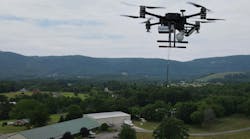ORLANDO, Fla., 7 Dec. 2006. CAE in Ottawa is using its simulation technology to support a range of new homeland security initiatives across Canada. By leveraging its experience and simulation technologies from defense programs, CAE is supporting Canada's homeland security community with simulation-based solutions for planning, experimentation, training, and mission rehearsal.
This week at the Interservice/Industry Training, Simulation, and Education Conference (I/ITSEC) in Orlando, Fla., CAE is demonstrating its expertise and simulation technologies for command and control in homeland security operations. I/ITSEC is the world's largest simulation and virtual reality exhibition.
CAE Professional Services is collaborating with government and industry partners to develop simulation-based analytical and decision support tools for emergency operation centers and training programs for frontline responders.
"Our new simulation capability at the building, site, and city levels, combined with command team simulation, provides the infrastructure we need for simulation centers in emergency colleges," says Mike Greenley, CAE's vice president of modeling and simulation. "Our light simulation and flexible visualization tools allow us to create simulation-based decision aids for operations centers."
CAE has been awarded contracts over the past two months to support the following programs in Canada:
* Simulation-Based Analytical Framework for Capability Development ¿ Under the Chemical, Biological, Radiological and Nuclear (CBRN) Research and Technology Initiative (CRTI), Defense Research and Development Canada (DRDC) has contracted CAE to develop a simulation-based emergency response and management experimentation capability to support analysis, training, and operational rehearsal for Canadian homeland security organizations. Through CAE's Capability Engineering and Design Approach (CEDATM), CAE's Professional Services team is analyzing the collective all-agency response to emergencies and using this analysis to design an "Interoperability Framework". The framework will be used within a simulation environment to support a series of distributed simulation-enabled emergency response exercises designed to study and assess alternative response configurations with a goal of addressing increased interoperability across all levels of government.
* Polyguard ¿ CAE has received research and development funding from Precarn Inc., a not-for-profit organization dedicated to funding leading-edge technology developments in Canada, to develop Polyguard - a next-generation technology for intelligent resource planning and scheduling for first responder deployment. Polyguard will be implemented by Ottawa Paramedic Services in 2008. CAE will develop a simulation-based solution that visualizes real-time and near real-time data in a three-dimensional and two-dimensional geographical information system (GIS) based common operating picture for resource allocation and scheduling to support command centre decision making.
* George Brown College Simulation-Based Emergency Operations Center ¿ CAE is supporting the development of George Brown College's simulation-based emergency operations centre in Toronto, Canada. The emergency operations center, which is scheduled for completion in early 2007, will be used as a training centre for students of George Brown College's School of Emergency Management. Students will "experience" terrorist attacks and disaster scenarios within a simulation-based virtual command centre environment, allowing them to engage in role-playing exercises while acting as a member of a multi-agency response team. This environment will also allow students to plan emergency response strategies and practice them in simulation, testing the theories they have learned in the classroom.
For more information, visit www.cae.com.


